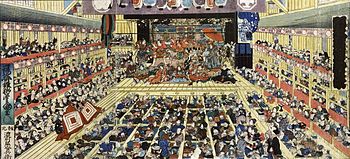42:
195:
22:
162:, "main flower path"), was first conceived and standardized in 1740. The standard size ranges from 16.38 metres (53.7 ft) – 18.20 metres (59.7 ft) long and 150 centimetres (59 in) – 180 centimetres (71 in) wide. Some theatres have since begun to make use of a secondary
135:, in the form of a simple wooden plank that reached from the centre of the stage to the middle of the theatre. It was not used in performances, but allowed actors to step into the audience after a performance to receive flowers, with the word
106:
also typically features a trapdoor just before the runway meets the stage, placed to be visible to everyone in the audience, which is commonly used for character entrances. Some kabuki plays also require the use of two
247:(lit., "seven-three"). It is here that exiting characters may say their final words, and entering characters may address the audience or the characters on stage. Since the
253:
runs through the audience, it allows for a closer experience for the spectator than might normally be allowed by other forms of traditional theater.
222:
Though rarely used for the main action of a play, much of the more dramatic or famous character moments occur during entrances or exits along the
338:
87:. It is a long, raised platform, running left of centre to the stage through the audience, connecting to the main stage.
41:
343:
194:
333:
52:
328:
21:
323:
74:
317:
307:
130:
100:
and scenes that do not take place in the location as scenes on the main stage; the
27:
228:. Many particularly dramatic actions take place seven-tenths of the way down the
96:
is typically used for character entrances and exits, though is also used for
201:
291:
84:
286:
81:
180:, "copied flower path") which is one-third to half the width of the
234:(three-tenths away from the stage), at a spot known in Japanese as
193:
97:
78:
40:
262:
16:
Runway leading from the back of a kabuki theatre to the stage
308:
113:, running along the left and right of the audience.
272:
266:
248:
240:
229:
223:
213:
207:
199:
181:
175:
169:
163:
157:
151:
145:
136:
128:
122:
108:
101:
91:
66:
46:
33:
25:
8:
168:on the right side of the audience, known as
20:
32:'s signature disappearing act on the
7:
14:
141:literally meaning "flower path."
208:
129:
127:was first used in 1668 in the
26:
1:
198:The July 1858 production of
339:1668 establishments in Asia
273:
267:
249:
230:
224:
214:
200:
182:
170:
164:
152:
146:
137:
123:
109:
102:
92:
47:
34:
360:
241:
176:
158:
67:
53:National Theatre of Japan
310:. Accessed 30 July 2005.
219:
55:
38:
197:
44:
24:
144:The modern style of
344:1660s introductions
150:, sometimes called
265:, the path to the
220:
212:theatre, with the
56:
39:
334:Stage terminology
271:is also known as
218:shown on the left
351:
276:
270:
252:
246:
244:
243:
233:
227:
217:
211:
210:
205:
185:
179:
178:
173:
167:
161:
160:
155:
149:
140:
134:
133:
126:
112:
105:
95:
77:section used in
72:
70:
69:
50:
37:
31:
30:
359:
358:
354:
353:
352:
350:
349:
348:
314:
313:
300:
283:
259:
238:
209:Edo Ichimura-za
192:
171:"karihanamichi"
119:
64:
17:
12:
11:
5:
357:
355:
347:
346:
341:
336:
331:
326:
316:
315:
312:
311:
299:
296:
295:
294:
289:
282:
279:
258:
255:
191:
188:
153:"honhanamichi"
118:
115:
15:
13:
10:
9:
6:
4:
3:
2:
356:
345:
342:
340:
337:
335:
332:
330:
327:
325:
322:
321:
319:
309:
305:
302:
301:
297:
293:
290:
288:
285:
284:
280:
278:
275:
269:
264:
256:
254:
251:
237:
232:
226:
216:
204:
203:
196:
189:
187:
186:on the left.
184:
172:
166:
154:
148:
142:
139:
132:
131:Kawarazaki-za
125:
116:
114:
111:
104:
99:
94:
88:
86:
83:
80:
76:
63:
62:
54:
49:
43:
36:
29:
23:
19:
303:
260:
235:
221:
183:honhanamichi
143:
120:
89:
73:is an extra
60:
59:
57:
18:
138:'hanamichi'
329:Stagecraft
318:Categories
298:References
304:Hanamichi
274:hanamichi
250:hanamichi
236:shichisan
231:hanamichi
225:hanamichi
215:hanamichi
202:Shibaraku
165:hanamichi
147:hanamichi
124:hanamichi
110:hanamichi
103:hanamichi
93:hanamichi
61:hanamichi
48:hanamichi
35:hanamichi
306:(2001).
281:See also
79:Japanese
292:Catwalk
206:at the
117:History
85:theater
324:Kabuki
287:Kabuki
190:Usages
98:asides
82:kabuki
28:Benkei
268:dohyō
75:stage
263:sumo
257:Sumo
121:The
90:The
58:The
45:The
261:In
177:仮花道
159:本花道
51:at
320::
277:.
242:七三
68:花道
245:)
239:(
174:(
156:(
71:)
65:(
Text is available under the Creative Commons Attribution-ShareAlike License. Additional terms may apply.


